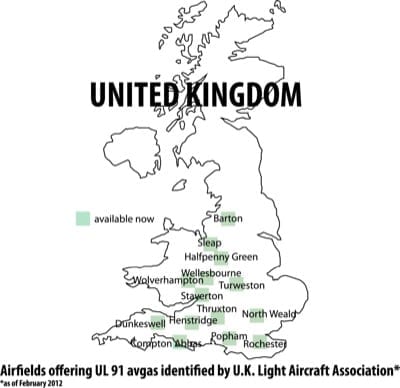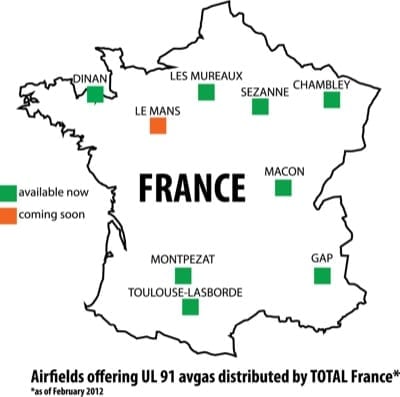Lycoming Engines has applied for approval to use UL 91 unleaded avgas in several of its engine models, including those in the 233, 235, 320 and 360 engine families. Engines in the 540 family will follow as Lycoming completes additional validation, Lycoming officials said.
Lycoming has submitted for ASTM D7547 UL 91 unleaded avgas approval on the engine models, officials said, noting UL 91 has entered into distribution in Europe largely to serve engines approved to operate on automotive specification fuels. European Aviation Safety Administration (EASA) Safety Information Bulletin 2011-01R1 provides aircraft level approval on the basis of engine approval.
Lycoming’s UL 91 approval will be announced via release of Lycoming Service Instruction 1070R. Together with the EASA Safety Information Bulletin, it will immediately enable the use of UL 91 on certain Lycoming-powered aircraft produced by manufacturers, including Cessna, Diamond, Piper, American Champion, Aviat, Maule, Tecnam, CubCrafters, Zenair, and more; certain Lycoming-powered helicopters produced by manufacturers including Robinson, Helicopteres Guimbal and more; experimental aircraft kits manufactured by Van’s, Glasair, Lancair, Zenith, Safari, Inpaer, and others; and all 233-powered aircraft.
“Many of our engines have been approved to operate on unleaded aviation fuel since 1995,” says Michael Kraft, Lycoming senior vice president and general manager. “Recognizing that not every fuel is available worldwide, we are continuously working to expand our specified fuels list to give pilots the flexibility they need to operate safely in the broadest range of locations. Our approval of UL 91 supports recent actions by European fuel producers and EASA to stabilize aviation fuel supplies for light aircraft and respond to environmental concerns over lead in aviation fuel.”
European Union EASA Safety Information Bulletin No. 2011-01R1 states that: “No additional approval is required for the aeroplane, provided the aeroplane is already approved for operation with avgas (according to ASTM D910, Def Stan 91-90, Mil-G-5572, GOST1012-72 or equivalent) or mogas and the engine is already approved to use unleaded avgas UL 91.”
 The Light Aircraft Association in the United Kingdom reports that nearly 15 U.K. airfields currently offer UL 91 and another 10 are making arrangements to offer the fuel. Manufacturer TOTAL also reports that the fuel is available at 13 airfields in France and Switzerland, with some more preparing to offer it. Plans are also in place to offer the fuel at airfields in Germany and Belgium.
The Light Aircraft Association in the United Kingdom reports that nearly 15 U.K. airfields currently offer UL 91 and another 10 are making arrangements to offer the fuel. Manufacturer TOTAL also reports that the fuel is available at 13 airfields in France and Switzerland, with some more preparing to offer it. Plans are also in place to offer the fuel at airfields in Germany and Belgium.
“Avgas UL 91 is more environmentally friendly and our goal is make it more widely available at airfields in Europe,” says François Guay, senior aviation fuel development manager of TOTAL in France, which produces UL 91. “Lycoming’s approval will help widen our coverage and distribution.”
 When finalized, the Lycoming approval will enable engines and their respective aircraft originally certified to operate on 80/87 leaded aviation fuel and/or 91-93 AKI automotive fuel to also operate legally on ASTM D7547 UL 91 in the European Union, Kraft says. In the United States, UL 91 will require an additional approval by the airframe manufacturer to operate aircraft using that fuel. There are no known distributors of UL 91 in the United States at this time, Kraft noted.
When finalized, the Lycoming approval will enable engines and their respective aircraft originally certified to operate on 80/87 leaded aviation fuel and/or 91-93 AKI automotive fuel to also operate legally on ASTM D7547 UL 91 in the European Union, Kraft says. In the United States, UL 91 will require an additional approval by the airframe manufacturer to operate aircraft using that fuel. There are no known distributors of UL 91 in the United States at this time, Kraft noted.
“UL 91 is not a replacement for 100LL, but it is a very robust aviation-suitable alternative to automotive gasoline,” he adds. “For many regions of the world it may provide an aviation-purposed fuel at lower prices than 100LL for a significant segment of the fleet. Lycoming remains vigorously supportive of a long-term unleaded 100LL replacement fuel which could serve the entire installed base.”
For more information: Lycoming.com
People who read this article also read articles on airparks, airshow, airshows, avgas, aviation fuel, aviation news, aircraft owner, avionics, buy a plane, FAA, fly-in, flying, general aviation, learn to fly, pilots, Light-Sport Aircraft, LSA, and Sport Pilot.

Why doesn’t all these brillant minds come up with a way to eliminate all petroleum fuels and use H2O – with global warming coming – this would be a “win-win” for all!
when can we burn Jet-A in a relic Lyc?
Seems a bit strange. Â ASTM D7547 was developed for the U.S. DOD specifically for the Rotax 914 used in the Predator drone. Â If you go through and read all of the ASTM documentation for D7547 it says over and over it is for DOD procurement of unleaded fuel for drones. Â What is particularly odd is that there is now an ASTM work group trying to add a specification to it for a trace amount of TEL, exactly the same trace amount of TEL that is in Hjelmco 91/96 UL which is ASTM D910 compliant. Â Why would you add TEL to an unleaded spec for the Rotax 914 used in drones? Â Why doesn’t Total which is the company distributing this new fuel in Europe just distributing Hjelmco 91/96UL?
It’s all very confusing. Â Is UL91 a new avgas, or is it autogas by another name?
“European Union EASA Safety Information Bulletin No. 2011-01R1 states
that: “No additional approval is required for the aeroplane, provided
the aeroplane is already approved for operation with avgas (according to
ASTM D910, Def Stan 91-90, Mil-G-5572, GOST1012-72 or equivalent) or
mogas and the engine is already approved to use unleaded avgas UL 91.â€
This appears to allow UL91 in an engine already approved for autogas. But what approval, via a TC or an STC ?  And, if this is so, why create a new fuel standard if autogas is sufficient?
Given that the EAA and Petersen Aviation invested millions to obtain STCs from the FAA, and Europeans have flown for years with autogas using these STCs, it appears that Total, with Lycoming’s help, is reaping the benefit without compensating the EAA or Petersen. Â
Lycoming says 91UL is not autogas. EASA seems to say it is.
Very confusing.